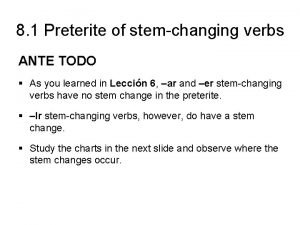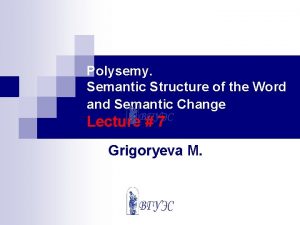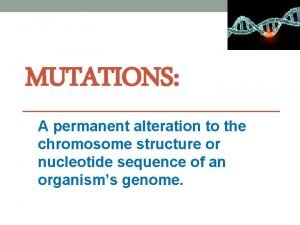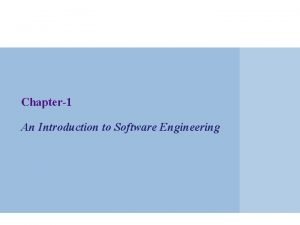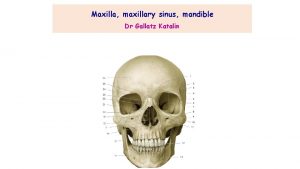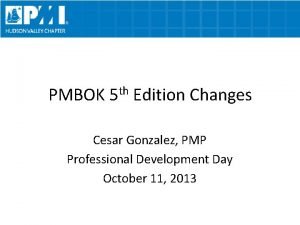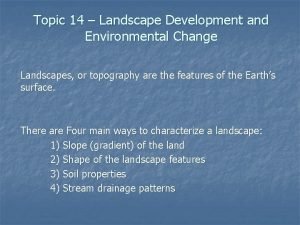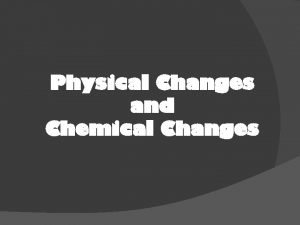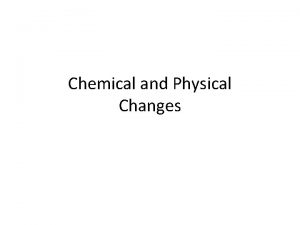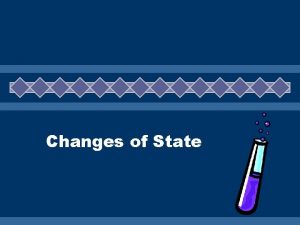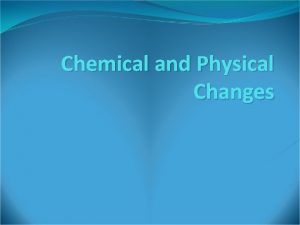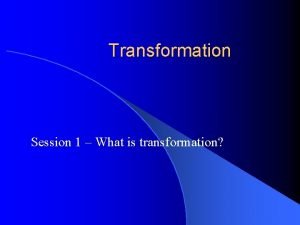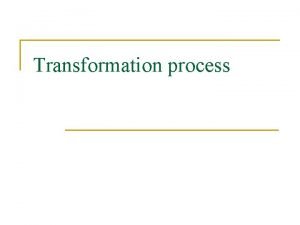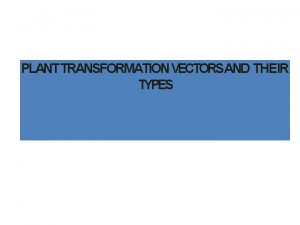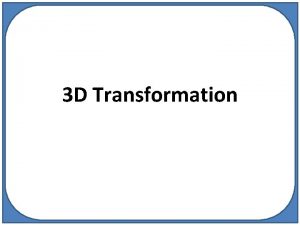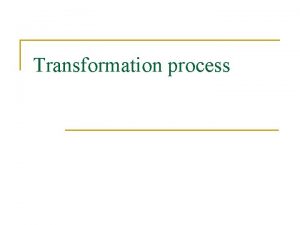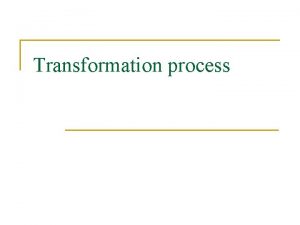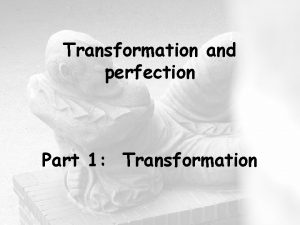2 D Transformation 2 D Transformation Transformation changes














































- Slides: 46

2 D Transformation

2 D Transformation • Transformation changes an object’s: – Position – Size – Orientation – Shape (Translation) (Scaling) (Rotation) (Deformation) • Transformation is done by a sequence of matrix operations applied on vertices.

Vector Representation • If we define a 2 D vector as: • A transformation in general can be defined as:

Transformation: Translation • Given a position (x, y) and an offset vector (tx, ty):

Transformation: Translation • To translate the whole shape:

Transformation: Rotation • Default rotation center: origin

Transformation: Rotation • If We rotate around the origin, • How to rotate a vector (x, y) by an angle of θ ? • If we assume:

Transformation: Rotation Before Rotation After Rotation

Transformation: Rotation • To translate the whole shape:

Transformation: Scaling • Change the object size by a factor of s: (4, 2) (2, 1) s=2 (-2, -1) (-4, -2)

Transformation: Scaling • But when the object is not center at origin (10, 6) (5, 3) (6, 4) s=2 (3, 2) (1, 1) (2, 2)

Transformation: Scaling • Isotropic (uniform) scaling or • Anistropic (non-uniform) scaling or

Summary • Translation: • Rotation • Scaling

Summary • Translation: • Rotation • Scaling We use the homogenous coordinate to make sure transformations have the same form.

Why use 3 -by-3 matrices? • Transformations now become the consistent. • Represented by as matrix-vector multiplication. • We can stack transformations using matrix multiplications.

Some math… • Two vectors are orthogonal if:

A Quiz

Some math… • A matrix and only if: is orthogonal if

Some math… • A matrix M is orthogonal if and only if: Diagonal Matrix

Some math… • A vector is normalized if:

Some math… • A matrix if and only if: Ortho: Normalized: is orthonormal

Some math… • A matrix M is orthonormal if and only if: Identity Matrix

Examples • A 2 D rotational matrix is orthonormal: Ortho: Normalized:

Examples • Is a 2 D scaling matrix orthonormal? (if sx, sy is not 1) Ortho: Normalized:

Summary Transformation Exists? Ortho? Normalized? Translation No NA NA Rotation Yes Yes Scaling Yes No 2 D Transformation (2 -by-2 matrix) Transformation Exists? Ortho? Normalized? Translation Yes No No Rotation Yes Yes Scaling Yes No 2 D Transformation (3 -by-3 matrix)

Transformation: Shearing • y is unchanged. • x is shifted according to y. or

Transformation: Shearing or

Facts about shearing • Any 2 D rotation matrix can be defined as the multiplication of three shearing matrices. • Shearing doesn’t change the object area. • Shearing can be defined as: rotation->scaling->rotation

In fact, • Without translation, any 2 D transformation matrix can be defined as: Rotation->Scaling->rotation Orthonormal Diagonal Orthonormal Singular Value Decomposition (SVD)

Another fact • Same thing when using homogenous coordinates: Orthonormal Diagonal Orthonormal

Conclusion • Translation, rotation, and scaling are three basic transformations. • The combination of these can represent any transformation in 2 D. • That’s why Open. GL only defines these three.

Rotation Revisit Rotate about the origin Rotate about any center?

(ox, oy) Arbitrary Rotation = Step 1: Translate (-ox, -oy) Step 2: Rotate (θ) Step 1: Translate (ox, oy)

Scaling Revisit (10, 6) (6, 4) (5, 3) (2, 2) (10, 6) (3, 2) (1, 1) (3, 2)

Arbitrary Scaling (ox, oy) = Step 1: Translate (-ox, -oy) Step 2: Scale(sx, sy) (ox, oy) can be arbitrary too! Step 1: Translate (ox, oy)

Rigid Transformation • A rigid transformation is: Orthonormal Matrix • Rotation and translation are rigid transformation. • Any combination of them is also rigid.

Affine Transformation • An affine transformation is: • Rotation, scaling, translation are affine transformation. • Any combination of them (e. g. , shearing) is also affine. • Any affine transformation can be decomposed into: Translation->Rotation->Scaling->Rotation (Last) (First)

We can also compose matrix Translation M 1 Scaling M 2 Rotation M 3 Translation M 4 v’ v’ = (M 1 (M 2( M 3 (M 4 v)))) v’ = M v v

Some Math • Matrix multiplications are associative: • Matrix multiplications are not commutative: • Some exceptions are: • Translation X Translation • Scaling X Scaling • Rotation X Rotation • Uniform scaling X Rotation

For example • Rotation and translation are not commutative: Orders are important!

How Open. GL handles transformation • All Open. GL transformations are in 3 D. • We can ignore z-axis to do 2 D transformation.

For example • 3 D Translation gl. Translatef(tx, ty, tz) • 2 D Translation gl. Translatef(tx, ty, 0)

For example • 3 D Rotation gl. Translatef(angle, axis_x, axis_y, axis_z) • 2 D Rotation gl. Translatef(angle, 0, 0, 1) Z-axis (0, 0, 1) to toward you

Open. GL uses two matrices: Each object’s local coordinate Model. View Matrix Each object’s World coordinate For example: Projection Matrix Screen coordinate glu. Ortho 2 D(…)

How Open. GL handles transformation • So you need to let Open. GL know which matrix to transform: gl. Matrix. Mode(GL_MODELVIEW); • You can reset the matrix as: gl. Load. Identity();

For Example Xcode time!
 Changes in latitudes, changes in attitudes meaning
Changes in latitudes, changes in attitudes meaning What's a physical change
What's a physical change Change in position or size
Change in position or size Animal farm summary chapter 5
Animal farm summary chapter 5 Stem changing verbs spanish preterite
Stem changing verbs spanish preterite The rate at which velocity changes is called
The rate at which velocity changes is called Changes in the global value of ecosystem services
Changes in the global value of ecosystem services What is a physical change
What is a physical change Selection pressure
Selection pressure The cross changes everything
The cross changes everything Stereogenic center
Stereogenic center Class 4 evs chapter 9 changing families
Class 4 evs chapter 9 changing families Nfhs football rule changes 2020
Nfhs football rule changes 2020 Chemical properties and changes lesson 4
Chemical properties and changes lesson 4 Parallel meaning
Parallel meaning Chromosomal mutations
Chromosomal mutations Living things grow and change
Living things grow and change National federation wrestling rules
National federation wrestling rules Infancy physical changes
Infancy physical changes Change present tense to past tense
Change present tense to past tense Evaluate brian's first reaction after the pilot's attack
Evaluate brian's first reaction after the pilot's attack 2020 florida electrical code
2020 florida electrical code Introduction to software engineering
Introduction to software engineering Maxillary nasal process
Maxillary nasal process Changes affecting product management
Changes affecting product management My body changes
My body changes Egypt food
Egypt food Unit of enthalpy change
Unit of enthalpy change List of territorial changes
List of territorial changes What is an example of chemical and physical change
What is an example of chemical and physical change Visible changes austin
Visible changes austin Pmbok 5 changes
Pmbok 5 changes Social changes in the 1920s
Social changes in the 1920s Planning for choices and changes
Planning for choices and changes Dealing successfully with difficult changes in your life
Dealing successfully with difficult changes in your life The change of phase from gas to solid *
The change of phase from gas to solid * Changes in demand and supply
Changes in demand and supply Stages of human growth and development pictures
Stages of human growth and development pictures Lesson 2: measuring and expressing enthalpy changes
Lesson 2: measuring and expressing enthalpy changes Chapter 3 analyzing changes in financial position answers
Chapter 3 analyzing changes in financial position answers Physical and chemical changes
Physical and chemical changes A researcher decides to study cognitive changes
A researcher decides to study cognitive changes Www tabgold co za card changes
Www tabgold co za card changes Topic 14 landscape development and environmental change
Topic 14 landscape development and environmental change Orbital changes
Orbital changes Model of buyer behavior
Model of buyer behavior Describes changes in an individual's behavior arising
Describes changes in an individual's behavior arising




